Statistics show that about 70% of the population of our country has some problems with bite. And often people do not seek to correct them, arguing that only public and affluent people need to take care of the beauty of their teeth. But, unfortunately, the aesthetic component is only the tip of the iceberg, and the main danger of a malocclusion awaits beyond visible problems.

Prosthesis with malocclusion
Content
- 1 material little about malocclusion
- 2 Varieties malocclusion
- 3 insidious malocclusion
- 4 Identification malocclusion
- 5 Prosthetics malocclusion
- 5.1 Capa
- 5.2 Braces
- 5.3 dentures
- 5.4 Bridge
- 5.5 Implants
- 5.6 Video - Wrong bite: how to fix it
- 6 Methods of insurance against bite anomalies
A bit about wrongm bite
It is worth starting with the origin of this defect. Like most bone problems, an incorrect bite can be a consequence of:
- genetic regularity, because heredity has a primary influence on the formation of the child's jaw;
- respiratory tract diseases, for example, when forced mouth breathing disturbs the growth of the facial part of the skull, which causes the development of deformation;
- injuries sustained during the development of the dentition;
- bad habits in infancy, such as constant thumb sucking.
It should be noted that even a violation of posture can provoke a child's wrong bite. Banal scoliosis due to improper functioning of the dorsal muscles, can affect the work of the jaws.
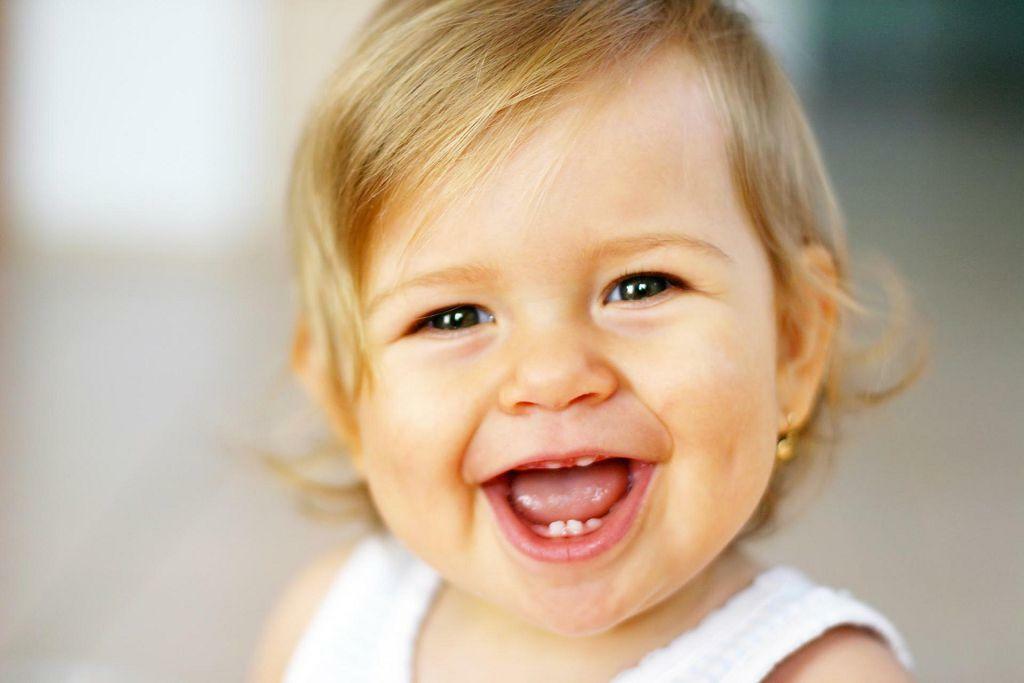
Even a violation of posture can cause the child to have a wrong bite
Varieties of an incorrect bite
The location of the jaws relative to each other is the determining factor in the process of occlusal diagnostics:
- distal , the development of which the upper jaw is more developed relatively lower. With this deviation, the pressure is distributed unevenly, so that the back teeth take on the load of the forelegs, which is a favorable soil for the development of caries on them. The main feature of the distal occlusion is a disproportionately small chin. With the passage of years leads to premature development of periodontitis and periodontitis;
- mesial , characterized by excessive extension of the lower jaw. A clear sign of this deformation is the protruding chin of the patient. Such a change contributes to impaired chewing function and early development of inflammatory diseases of teeth and gums;
- deep , diagnosed when the upper teeth fall behind the lower one for a distance exceeding the length of their crown. Often with this type of bite, the face has insufficient height, and the lip is constantly in an inverted position due to lack of space. Over time, the first consequence may be periodontitis, that is, loosening of the teeth, as well as permanent damage to the teeth of the oral mucosa.
- open , which is the impossibility of closing jaws to each other. This pathology can be observed both in the anterior part of the jaw, and in the lateral. Invariably a slightly open mouth, or a general asymmetry of the face - these are obvious signs of an open bite;
- cross , observed with underdevelopment of one side of the jaw. This deformation primarily affects the chewing function, as patients are forced to chew predominantly on one side of the jaw. The main goal of the treatment is the alignment of both sides of the jaw relative to each other.
- is a dystopia , which affects the location of the teeth in its "place".For the most part it is a consequence of the violation of the timing and sequence of teething. The teeth that have changed their location can injure the mucous membranes of the tissues of the mouth, and also lead to the development of erosion.

Visual representation of the types of abnormal bite
If an occlusion defect is detected at its early stage, then the treatment can be sparing, and the elimination of the problem is fast enough and not costly. Therefore, it is so important to conduct systematic preventive examinations.
Insidious malocclusion of the
Incorrect bite entails a whole series of unpleasant consequences, some of which are very difficult to eliminate:
- increased load on individual teeth, resulting in accelerated abrasion of the enamel and, as a consequence, increased sensitivity;
- disorders in the work of the articulatory apparatus. Often, an incorrect bite becomes the primary cause of lisps and other dyslexia disorders due to the forced unnatural position of the tongue;
- accumulation of plaque in the places where the teeth overlap, which leads to the development of caries, periodontitis and other diseases of teeth and gums;
- deformation in the temporomandibular joint, which is quite difficult to correct due to its three-dimensional structure;
- in difficult cases, there may also be difficulties with eating and breathing.
The consequence of an incorrect bite can also be headaches and even pain when chewing food.
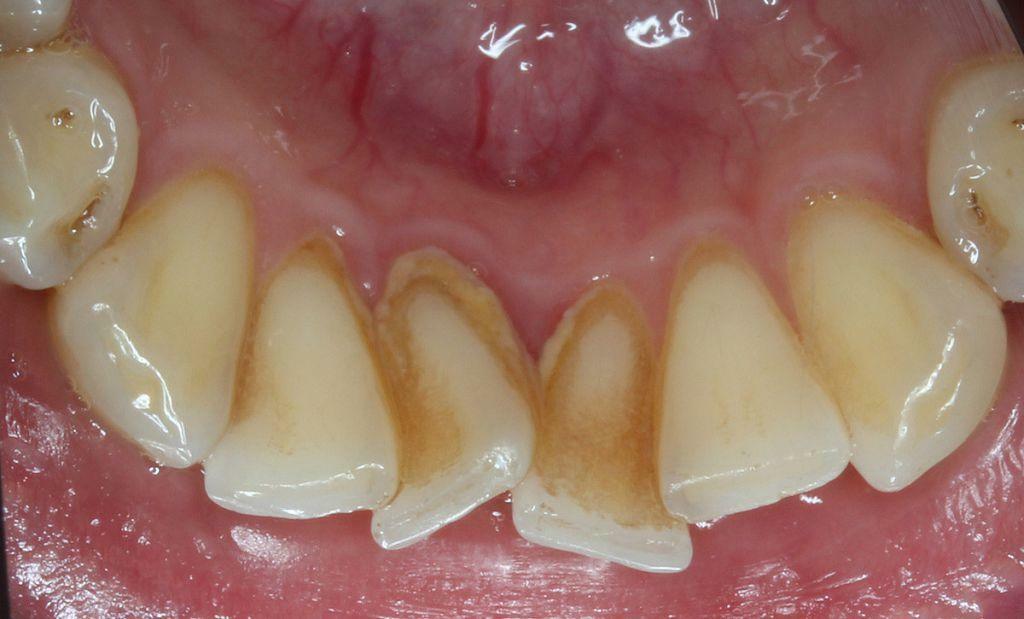
Incorrect bite causes the development of tooth decay, periodontitis and other diseases of teeth and gums.
. Detection of an incorrect bite.
. There are several most obvious signs of a defective bite that allows it to be identified:
- protruding lower jaw;
- drawn upper lip;
- abnormally closing dentition;
- unevenly growing teeth.
These are only the most obvious signs of existing deviations. Put a more accurate diagnosis and appoint the appropriate treatment can only the doctor-orthodontist.
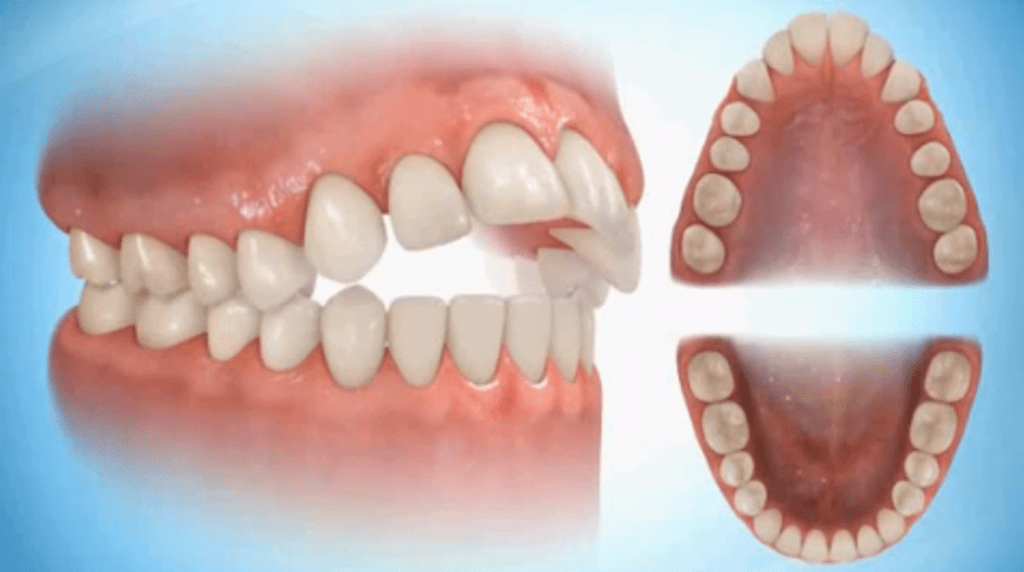
Visual image of open bite
Prosthetic malocclusion
When the problem with bite is started, the only way out is prosthetics, which can restore proper rowing of the teeth. There are several methods of prosthetics that allow to combat bite problems:
Kapa
Represents a removable patch on the teeth of a transparent polymer that struggles with curvatures of the teeth with the help of pressure. They allow to achieve the result without appreciable discomfort and painful sensations. There are several varieties of cap for bite correction:
- standard , manufactured without regard for personal characteristics. Has a low cost, but is not able to deal with complex cases of curvature;
- thermoplastic , which repeats the contours of the teeth thanks to the individual production of a special polymer. They have a short production time and ample opportunities for use, but they have a slightly higher cost;
- invisible , manufactured using a gypsum model and using 3D modeling. The most expensive and effective variety of cap. Is able to cope with small deformations without excessive discomfort.
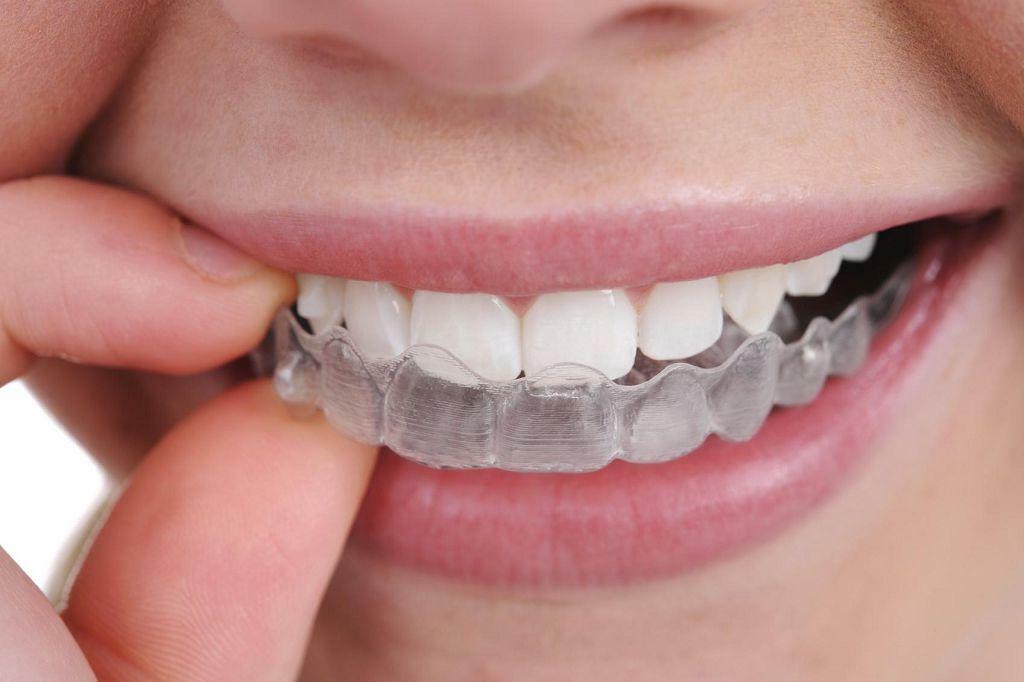
Dentifrice for the alignment of teeth
Brackets
Thanks to its design, it can correct almost any dental deformity, except in extremely difficult cases requiring surgical intervention. There are 2 basic types of braces:
- vestibular , attached to the frontal part of the tooth;
- lingual , placed on the inner surface of the tooth, which makes them invisible to others.
Can be made of a wide variety of materials: metal, ceramics and even semi-precious stones.
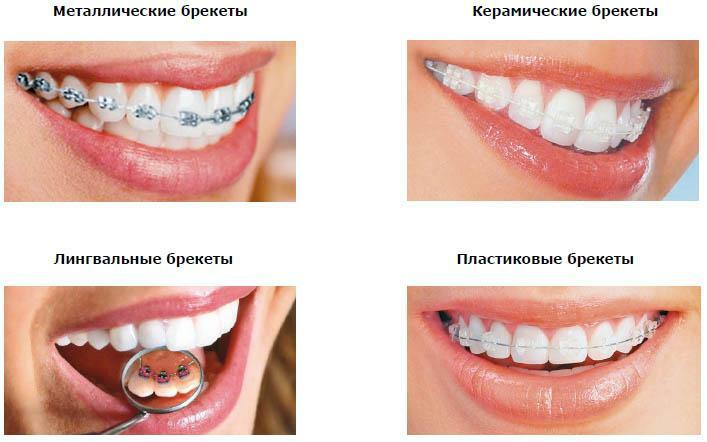
Types of brackets for correcting an incorrect bite
Removable prosthesis
Used in the almost complete absence of a number of teeth. Produced mainly from hypoallergenic acrylic and can be of the following types:
- full, used in the case of complete absence of teeth on the jaw, are fixed to the gum directly;
- partial, used in the absence of several teeth in a row and fastened both to the problem jaw and to the remaining adjacent teeth.
Differs durability and relatively low cost, as well as the possibility of individual selection due to an extremely wide range of colors.
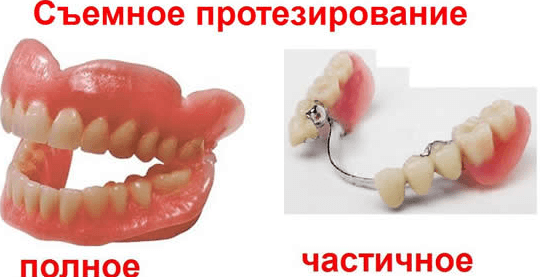
Types of prosthetic teeth
Bridge
This variety is a series of interconnected tooth crowns on a metal base. They rigidly fasten on neighboring natural teeth with fixing elements.100% return the chewing efficiency of the jaw and does not break the tactile, taste and temperature sensations. The use of metal in the design can significantly increase its service life, but increases the final cost of the product.
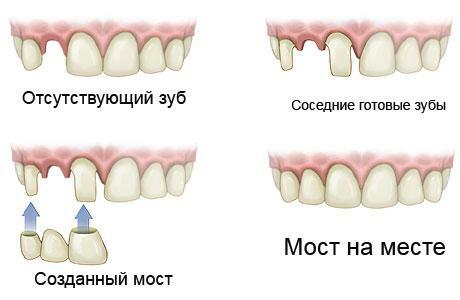
So put a "bridge" on the teeth
Implants
The most modern method of prosthetics with bite deformity. It is implanted directly into the bone tissue with the subsequent fixation of the denture on it. The most durable way of all presented, with a virtually lifetime warranty. The aesthetic component of this method is also beyond any competition, because even on closer inspection it is impossible to distinguish between an implanted design and a natural tooth.
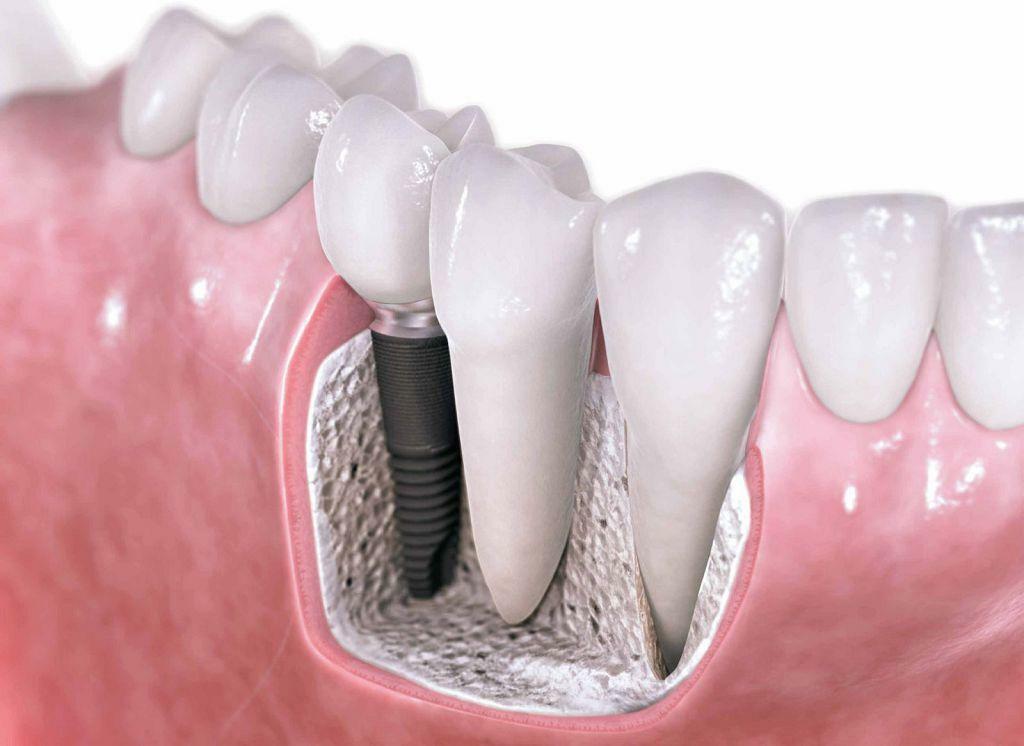
Visible image of tooth implants
It is important to remember that approximately up to 7 years you can correct the defect of bite with the help of massage of problem areas and special gymnastics. It is necessary to wean the child from bad habits, so that later it does not have to resort to complex, long and expensive methods of treatment.
Video - Wrong bite: how to fix it
Methods of insurance against bite anomalies
It is worth remembering that the main causes of abnormalities are born in early childhood, so, for the most part, the responsibility for the twisted jaws of children rests with their parents. And if there is no obvious genetic anomaly, then you just have to adhere to the following simple rules:
| Recommendation | Reasons for deviations | What to do |
|---|---|---|
| Monitor your health during pregnancy | Teeth mineralization begins at week 20 of pregnancy | Control the amount of calcium and fluoride-containing elements consumed |
| Correctly to feed the newborn | Uneven development of muscles with wrong sucking | Pay attention to the correct work of the facial muscles when sucking |
| nasal breathing of a child | The habit of breathing with the mouth causes an open bite | Ensure that the child is predominantly breathing nose |
| Exhaust from bad habits | Sucking fingers and nipples during the eruption of the first teeth can cause them to curl later | Control the appearance of these habits and maximizethey are quickly replaced by |
It is worth remembering that the teeth of each patient are unique, and requires individual selection of treatment methods. There are no universal ways to get rid of the problem. Only a carefully conducted diagnostic check by a specialist will make it possible to make an accurate diagnosis on the basis of photographs and casts.
Before going to a specialist, you should immediately adjust to the fact that correcting an incorrect bite is a lengthy procedure that requires patient patience, and sometimes even a rejection of established habits.
Wearing braces, for example, requires not only certain food restrictions, but also regular procedures for cleaning and maintenance of the installed structure.
Do not forget that this long process will bring a lot of positive results, which will subsequently reflect not only on the exterior, but also on the internal self-perception.
And then it will be possible without extra modesty to give your beautiful smile to others!



